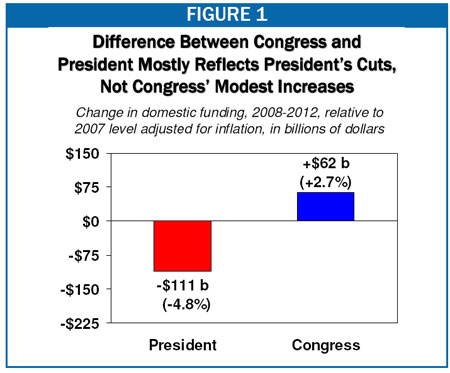|
November 14, 2007
THE PRESIDENT’S MISLEADING ATTACK ON CONGRESS’S
APPROPRIATIONS PLAN:
Charge of $205 Billion Spending Increase Is a Distortion
By Richard Kogan
In vetoing the appropriations bill funding the Departments of Labor, Health and Human Services, and Education, the President charged yesterday that Congress plans an irresponsible increase of $205 billion over the next five years in domestic discretionary spending (spending on domestic programs funded through the appropriations process) over the levels he proposed. This claim of a $205 billions increase is misleading in a number of respects.
- Most of the difference between the President’s and Congress’s proposed funding levels reflects Congress’s rejection of his proposed cuts in domestic appropriations.

The President has proposed a $111 billion (or 4.8 percent) cut over five years, below the 2007 level adjusted for inflation, in domestic discretionary programs. Congress plans an increase of $62 billion (or 2.7 percent). The difference between the President and Congress thus is $173 billion — not $205 billion. The remaining “difference” reflects the White House’s use of a gimmick to make its own proposed level of discretionary spending appear $30 billion lower than it actually is (see the box below).
- The above figures understate the President’s proposed cut and overstate Congress’s proposed increase because they do not adjust for population growth.
Many analysts have concluded — and President Bush himself argued when he ran for President in 2000[1] — that adjusting for both inflation and population growth is the most accurate way to measure increases or reductions in funding levels over time. Only by factoring in population growth can one measure changes over time in what a given funding level will purchase on a per-person basis.
If one adjusts for population growth as well as inflation, the President’s cut rises to $169 billion over five years, while Congress’ increase shrinks to zero. In other words, Congress’ budget plan would provide exactly what is required to maintain the 2007 funding levels for domestic appropriated programs, adjusted for inflation and increases in the U.S. population.
- The only large increases in appropriated programs under Congress’s budget are in defense and international programs, not domestic programs, and reflect the President’s own funding requests.
Those increases, which total $252 billion (or 10.1 percent) over five years, are unrelated to Iraq, Afghanistan, and the global war on terror. That is, they do not count the $196 billion in additional funding the President has requested for operations in Iraq and Afghanistan
|
The $30 Billion Gimmick — Distorting Budget Figures to Serve Political Ends
As explained in this paper, the five-year difference in proposed discretionary funding between the President and Congress is $173 billion. How does the President get a figure of $205 billion?
Nearly all of the discrepancy is caused by a $30 billion gimmick in the White House’s accounting. The President’s budget proposes scrapping most existing aviation user fees, such as the airline ticket tax, and replacing them with new fees to support the air traffic control system, starting in 2009. The Administration and others believe the proposed fees would raise revenue in an economically sounder way.
The $30 billion in new fees would almost exactly equal the existing fees they would replace. Thus, the Administration’s change would merely substitute one fee for another. It would not shrink any domestic discretionary programs or the overall cost of the air traffic control system, and would affect neither the deficit nor the size of the government.
For technical accounting reasons, the elimination of the existing fees is recorded in the President’s budget as a tax cut of nearly $30 billion, while the new user charges would be accounted for as an offset to, or a “reduction” in, spending. But in presenting the collection of the new fees as a $30 billion reduction in discretionary spending, the White House is deceptively claiming that congressional Democrats favor another $30 billion in “irresponsible” discretionary spending increases over what the President has proposed.
The President’s own budget, issued in February, acknowledges that the proposed aviation fees do not constitute a reduction in domestic discretionary funding. In the section of that document proposing statutory caps on overall annual appropriations through 2012, the cap levels do not treat the proposed new aviation fees as reductions in appropriated spending.* Consequently, those cap levels are $30 billion higher than the amount of appropriations funding that the President claims he favors over the next five years when he charges that Congress would increase spending by $205 billion.
*See Analytical Perspectives, Budget of the United States Government, OMB February 2007, page 212. |
End Notes:
[1] In 2000, the official George W. Bush for President website defended Mr. Bush against the charge that he had been a “big spender” when he was governor of Texas by saying, “When adjusted for inflation and population, state spending will increase by only 3.6 percent between 1994-1995 and the end of the 2000-2001 biennium.” Similarly, the Dallas Morning News reported on October 28, 1999: “Wednesday, Governor Bush said an ‘honest comparison’ of spending growth should take inflation and the state’s increasing population into account.” |

